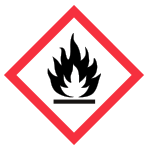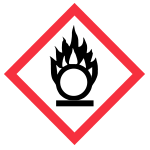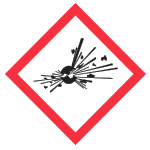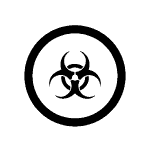WHMIS 2015 - Pictograms
Important Information
Canada has aligned the Workplace Hazardous Materials Information System (WHMIS) with the Globally Harmonized System of Classification and Labelling of Chemicals (GHS).
This document discusses the WHMIS requirements after the alignment of WHMIS with the GHS. Information in this document is based on the federal legislation – the amended Hazardous Products Act and the new Hazardous Products Regulations (HPR).
Health Canada is the government body responsible for making the required changes to the overall federal WHMIS-related laws. Note that WHMIS-related occupational health and safety regulations for the provinces, territories and federally regulated workplaces will also require updating.
While much is known with the federal legislation updates, legislative updates for each provincial or territorial jurisdiction may affect some of the information in this document.
The WHMIS 2015 legislation is currently in force. "In force" means that suppliers may begin to use and follow the new requirements for labels and safety data sheets (SDSs) for hazardous products sold, distributed, or imported into Canada. However, there is a transition period with various stages. At the outset of the transition period, the supplier must fully comply with either the repealed Controlled Products Regulations (WHMIS 1988) or the HPR (WHMIS 2015) for a specific controlled or hazardous product. The classification, label and (material) SDS must comply fully with the specific regulation chosen by the supplier, and not be a combination of the two.
Please refer to the following OSH Answers documents for information about WHMIS 2015:
- WHMIS 2015 – General
- WHMIS 2015 – Labels
- WHMIS 2015 – Hazard Classes and Categories
- WHMIS 2015 – Safety Data Sheets (SDSs)
- WHMIS 2015 – Education and Training
- WHMIS 2015 – WHMIS Program
- WHMIS 2015 – Glossary
- WHMIS 2015 – Confidential Business Information (CBI)
- WHMIS 2015 – Variances
- WHMIS 2015 – Laboratories
What is a pictogram?
Pictograms are graphic images that immediately show the user of a hazardous product what type of hazard is present. With a quick glance, you can see, for example, that the product is flammable, or if it might be a health hazard.
Most pictograms have a distinctive red "square set on one of its points" border. Inside this border is a symbol that represents the potential hazard (e.g., fire, health hazard, corrosive, etc.). Together, the symbol and the border are referred to as a pictogram. Pictograms are assigned to specific hazard classes or categories.
The graphic below shows hazard pictograms. The bold type is the name given to the pictogram; the words in the brackets describe the hazard.

What pictograms will be used with WHMIS 2015 hazard classes and categories?
The following pictograms will be associated with these hazard classes and categories.

The flame pictogram is used for the following classes and categories:
- Flammable gases (Category 1)
- Flammable aerosols (Category 1 and 2)
- Flammable liquids (Category 1, 2 and 3)
- Flammable solids (Category 1 and 2)
- Pyrophoric liquids (Category 1)
- Pyrophoric solids (Category 1)
- Pyrophoric gases (Category 1)
- Self-heating substances and mixtures (Category 1 and 2)
- Substances and mixtures which, in contact with water, emit flammable gases (Category 1, 2 and 3)
- Self-reactive substances and mixtures (Types B*, C, D, E and F)
- Organic peroxides (Types B*, C, D, E and F)

The flame over circle pictogram is used for the following classes and categories:
- Oxidizing gases (Category 1)
- Oxidizing liquids (Category 1, 2 and 3)
- Oxidizing solids (Category 1, 2 and 3)

The gas cylinder pictogram is used for the following classes and categories:
- Gases under pressure (Compressed gas, Liquefied gas, Refrigerated liquefied gas, and Dissolved gas)

The corrosion pictogram is used for the following classes and categories:
- Corrosive to metals (Category 1)
- Skin corrosion/irritation - Skin corrosion (Category 1, 1A, 1B and 1C)
- Serious eye damage/eye irritation - Serious eye damage ( Category 1)

The exploding bomb pictogram is used for the following classes and categories:
- Self-reactive substances and mixtures (Types A and B*)
- Organic peroxides (Types A and B*)

The skull and crossbones pictogram is used for the following classes and categories:
- Acute toxicity -
- Oral (Category 1, 2 and 3)
- Dermal (Category 1, 2 and 3)
- Inhalation (Category 1, 2 and 3)

The health hazard pictogram is used for the following classes and categories:
- Respiratory or skin sensitization - Respiratory sensitizer (Category 1, 1A and 1B)
- Germ cell mutagenicity (Category 1, 1A, 1B and 2)
- Carcinogenicity (Category 1, 1A, 1B, and 2)
- Reproductive toxicity (Category 1, 1A, 1B and 2)
- Specific Target Organ Toxicity - Single exposure (Category 1 and 2)
- Specific Target Organ Toxicity - Repeated exposure (Category 1 and 2)
- Aspiration hazard (Category 1)

The exclamation mark pictogram is used for the following classes and categories:
- Acute toxicity – Oral, Dermal, Inhalation (Category 4)
- Skin corrosion/irritation – Skin irritation (Category 2)
- Serious eye damage/eye irritation – Eye irritation (Category 2 and 2A)
- Respiratory or skin sensitization – Skin sensitizer (Category 1, 1A and 1B)
- Specific target organ toxicity – Single exposure (Category 3)

The biohazardous infectious materials pictogram is used for the following classes and categories:
- Biohazardous Infectious Materials (Category 1)
* Both the Flame and Explosive pictogram are used for Self-reactive substances and mixtures (Type B) and Organic peroxides (Type B)
NOTE: Physical Hazards Not Otherwise Classified and Health Hazards Not Otherwise Classified classes are required to have a GHS pictogram that is appropriate to the hazard identified.
Do all hazard classes and categories require a pictogram?
No. There are hazardous products that meet the criteria for a hazard class or category, but these classes and categories do not require a pictogram. The product label and Section 2 (Hazards Identification) of the SDS still require the signal word, hazard statement(s), and other required label elements.
WHMIS 2015 classes and categories that do not require a pictogram are:
- Flammable gases – Category 2
- Flammable liquids – Category 4
- Self-reactive substances and mixtures – Type G
- Organic peroxides – Type G
- Combustible dusts – Category 1
- Simple Asphyxiants – Category 1
- Serious eye damage/eye irritation – Eye Irritation – Category 2B
- Reproductive toxicity – Effects on or via lactation
Where will I find the pictograms?
Pictograms will be on the product supplier labels of the hazardous products you work with. They will also be on the SDSs (as the symbol or words that describe the symbol). Please see the following for more information:
You may also be interested in our WHMIS 2015 Pictograms poster and our WHMIS 2015 Pictograms Kit.
Add a badge to your website or intranet so your workers can quickly find answers to their health and safety questions.
Disclaimer
Although every effort is made to ensure the accuracy, currency and completeness of the information, CCOHS does not guarantee, warrant, represent or undertake that the information provided is correct, accurate or current. CCOHS is not liable for any loss, claim, or demand arising directly or indirectly from any use or reliance upon the information.




